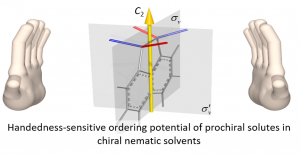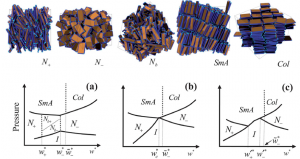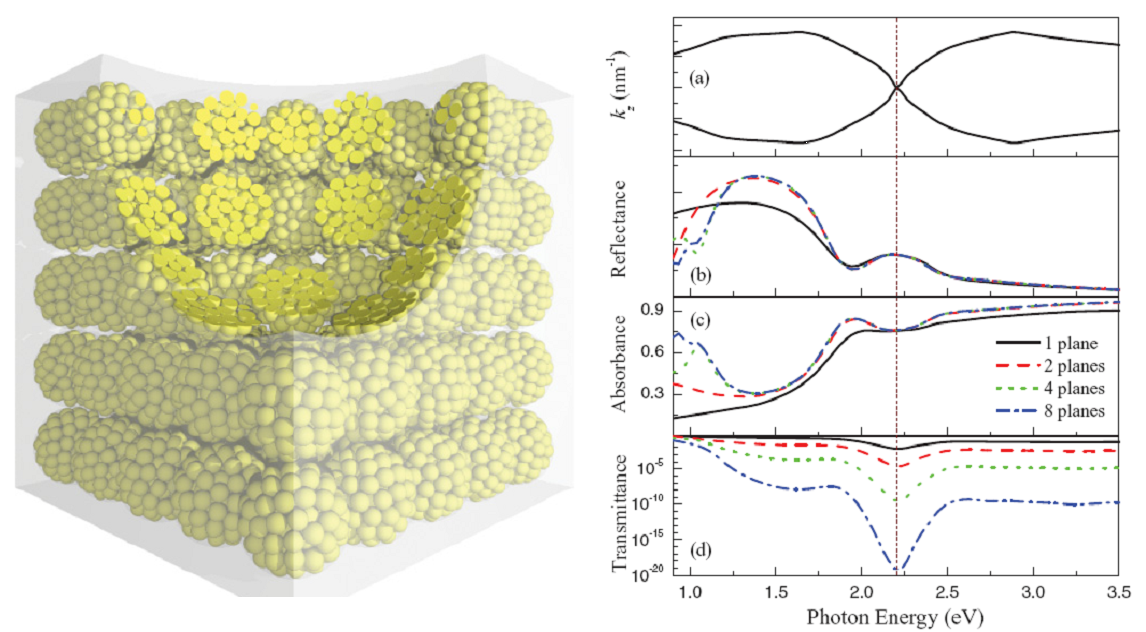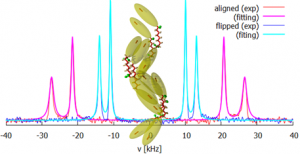Anant Kumar, Alexandros G. Vanakaras and Demetri J. Photinos, J. Phys. Chem. B, Article ASAP DOI: 10.1021/acs.jpcb.6b07404
ABSTRACT: We have developed a molecular theory for enantiotopic discrimination in prochiral solutes dissolved in chiral nematic solvents by means of NM R spectroscopy. The leading rank tensor contributions to the proposed potential of mean torque include symmetric as well as antisymmetric terms with respect to spatial inversion; these lead to consistent determination of all prochiral solute symmetries for which enantiotopes are distinguishable by NMR and also to excellent quantitative agreement when tested against the available experimental data for the rigid solutes acenaphthene and norbornene as well as for the moderately flexible ethanol molecule.
R spectroscopy. The leading rank tensor contributions to the proposed potential of mean torque include symmetric as well as antisymmetric terms with respect to spatial inversion; these lead to consistent determination of all prochiral solute symmetries for which enantiotopes are distinguishable by NMR and also to excellent quantitative agreement when tested against the available experimental data for the rigid solutes acenaphthene and norbornene as well as for the moderately flexible ethanol molecule.
Zerihun G. Workineh and Alexandros G. Vanakaras, Polymers 2014, 6(8), 2082-2099; doi:10.3390/polym6082082
 Abstract: The surface alignment of liquid crystalline dendrimers (LCDrs) is a key factor for many of their potential applications. Here, we present results from Monte Carlo simulations of LCDrs adsorbed on flat, impenetrable aligning substrates. A tractable coarse-grained force field for the inter-dendritic and the dendrimer-substrate interactions is introduced. We investigate the conformational and ordering properties of single, end-functionalized LCDrs under homeotropic, random (or degenerate) planar and unidirectional planar aligning substrates. Depending on the anchoring constrains to the mesogenic units of the LCDr and on temperature, a variety of stable ordered LCDr states, differing in their topology, are observed and analyzed. The influence of the dendritic generation and core functionality on the surface-induced ordering of the LCDrs are examined.
Abstract: The surface alignment of liquid crystalline dendrimers (LCDrs) is a key factor for many of their potential applications. Here, we present results from Monte Carlo simulations of LCDrs adsorbed on flat, impenetrable aligning substrates. A tractable coarse-grained force field for the inter-dendritic and the dendrimer-substrate interactions is introduced. We investigate the conformational and ordering properties of single, end-functionalized LCDrs under homeotropic, random (or degenerate) planar and unidirectional planar aligning substrates. Depending on the anchoring constrains to the mesogenic units of the LCDr and on temperature, a variety of stable ordered LCDr states, differing in their topology, are observed and analyzed. The influence of the dendritic generation and core functionality on the surface-induced ordering of the LCDrs are examined.
Keywords: liquid crystal dendrimers; surface alignment; Monte Carlo simulations; surface confinement of dendrimer
Anke Hoffmann, Alexandros G. Vanakaras, Alexandra Kohlmeier, Georg H. Mehl, Demetri J. Photinos, arXiv:1401.5445 [cond-Mat]. (2014). http://arxiv.org/abs/1401.5445.
Abstract: NMR measurements on a selectively deuteriated liquid crystal dimer CB-C9-CB exhibiting two nematic phases show that the molecules in the lower temperature nematic phase, Nx, experience a chiral environment and are ordered about a unique direction. The results are contrasted with previous reports that proposed a twist-bend spatial variation of the director. A structural model is proposed wherein the molecules show organization into highly correlated assemblies of opposite chirality.
Stavros D. Peroukidis, Alexandros G. Vanakaras, S. D. Peroukidis, A G. Vanakaras, Soft Mater, 9, 7419-7423 (2013). DOI: 10.1039/C3SM51165K.
The rich mesophase polymorhism and the phase sequence of board-like colloids depends critically on their shape anisometry. Implementing  extensive Monte Carlo simulations, we calculated the full phase diagram of sterically interacting board-like particles, for a range of experimentally accessible molecular dimensions/anisometries of colloids of this shape. A variety of self organized mesophases including uniaxial and biaxial nematics, smectic, cubatic and columnar phases have been identified. Our results demonstrate clearly that the molecular anisometry influences critically not only the structure and the symmetry of the mesophases but also, and perhaps more interestingly, the phase sequence among them. New classes of phase sequences such as nematic-nematic and, for the first time, a direct transition from a discotic and a biaxial nematic to an orthogonal smectic A phase have been identified. The molecular geometry requirements for such a phase behavior have been located.
extensive Monte Carlo simulations, we calculated the full phase diagram of sterically interacting board-like particles, for a range of experimentally accessible molecular dimensions/anisometries of colloids of this shape. A variety of self organized mesophases including uniaxial and biaxial nematics, smectic, cubatic and columnar phases have been identified. Our results demonstrate clearly that the molecular anisometry influences critically not only the structure and the symmetry of the mesophases but also, and perhaps more interestingly, the phase sequence among them. New classes of phase sequences such as nematic-nematic and, for the first time, a direct transition from a discotic and a biaxial nematic to an orthogonal smectic A phase have been identified. The molecular geometry requirements for such a phase behavior have been located.
V. Yannopapas, N. Fyttas, V. Kyrimi, E. Kallos, A.G. Vanakaras, D.J. Photinos, PSSA, DOI: 10.1002/pssa.201228489.
We study the optical properties of gold nanoparticles (NPs) coated with a nematic liquid crystal (NLC) whose director field is distributed around the NP according to the anchoring conditions at the surface of the NP. The distribution of the NLC is obtained by minimization of the corresponding Frank free-energy functional whilst the optical response is calculated by the discrete-dipole approximation (DDA). We find, in particular, that the anisotropy of the NLC coating does not affect much the (isotropic) optical response of the NP. However, for strong anchoring of the NLC molecules on the surface of NP, the inhomogeneity of the coating which is manifested by a ring-type singularity (disclination or Saturn ring), produces an enhancement of the extinction cross spectrum over the entire visible spectrum.
V. Yannopapas and A. Vanakaras, Phys. Rev. B., 84, 045128, (2011).
 We report on the emergence of a Dirac point in the dispersion relation of a plasmonic metamaterial. It is realized as a three-dimensional crystal (cubic or orthorhombic) whose lattice sites are decorated by aggregates of gold nanoparticles embedded in a high-index dielectric material. The Dirac-type dispersion lines of the photon modes are not a result of diffraction as in photonic crystals but due to subwavelength features and emerge from the gapless transition from a negative to a positive index band. The Dirac point is manifested as a dip in the spectrum of light transmittance through a finite slab of the metamaterial; however, transmittance does not decrease diffusively but exponentially due to the inherent losses of gold in the given spectral regime. ©2011 American Physical Society
We report on the emergence of a Dirac point in the dispersion relation of a plasmonic metamaterial. It is realized as a three-dimensional crystal (cubic or orthorhombic) whose lattice sites are decorated by aggregates of gold nanoparticles embedded in a high-index dielectric material. The Dirac-type dispersion lines of the photon modes are not a result of diffraction as in photonic crystals but due to subwavelength features and emerge from the gapless transition from a negative to a positive index band. The Dirac point is manifested as a dip in the spectrum of light transmittance through a finite slab of the metamaterial; however, transmittance does not decrease diffusively but exponentially due to the inherent losses of gold in the given spectral regime. ©2011 American Physical Society
URL: http://link.aps.org/doi/10.1103/PhysRevB.84.045128
DOI: 10.1103/PhysRevB.84.045128
 R spectroscopy. The leading rank tensor contributions to the proposed potential of mean torque include symmetric as well as antisymmetric terms with respect to spatial inversion; these lead to consistent determination of all prochiral solute symmetries for which enantiotopes are distinguishable by NMR and also to excellent quantitative agreement when tested against the available experimental data for the rigid solutes acenaphthene and norbornene as well as for the moderately flexible ethanol molecule.
R spectroscopy. The leading rank tensor contributions to the proposed potential of mean torque include symmetric as well as antisymmetric terms with respect to spatial inversion; these lead to consistent determination of all prochiral solute symmetries for which enantiotopes are distinguishable by NMR and also to excellent quantitative agreement when tested against the available experimental data for the rigid solutes acenaphthene and norbornene as well as for the moderately flexible ethanol molecule.

